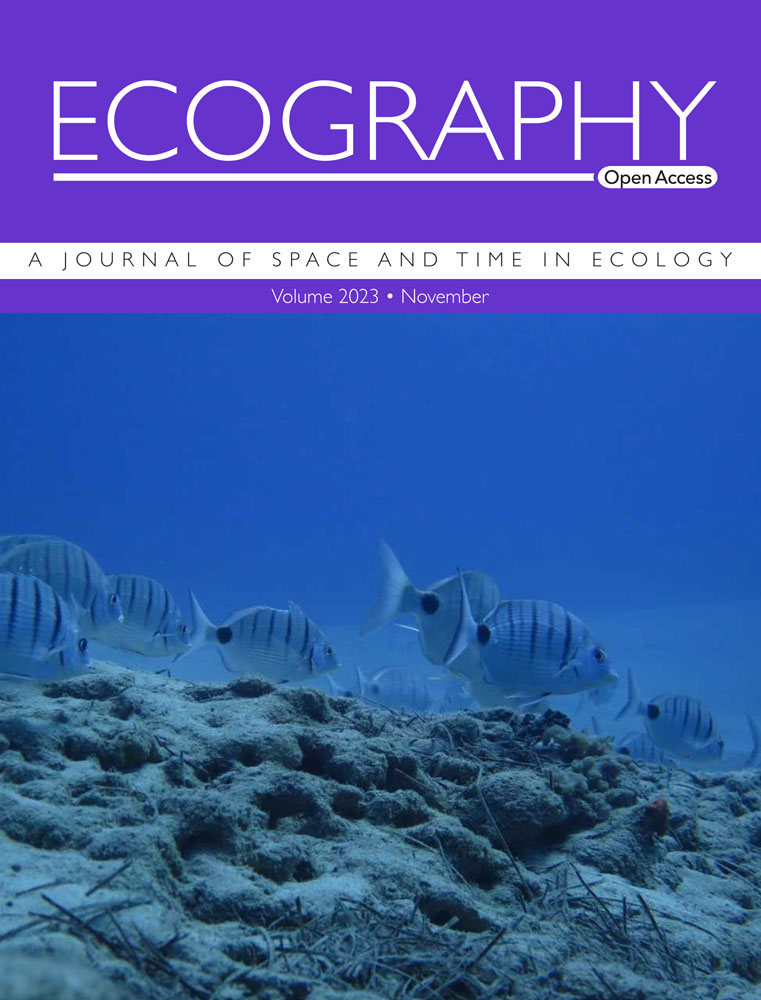Jaccard dissimilarity in stochastic community models based on the species-independence assumption
IF 5.4
1区 环境科学与生态学
Q1 BIODIVERSITY CONSERVATION
引用次数: 0
Abstract
A fundamental problem in ecology is understanding the changes in species composition among sites (i.e. beta-diversity). It is unclear how spatial heterogeneity in species occupancy across sites shapes patterns of beta-diversity. To address this question, we develop probabilistic models that consider two spatial or temporal sites, where presence probabilities vary both among species and between the sites. We derive analytical and approximate formulae for the expectation of pairwise beta-diversity. Using a graphical tool, stochastic incidence plots (SIPs), which depict the presence probabilities in two sites along species labels, we develop a means to conceptualize the heterogeneity in presence probabilities: the steepness or unevenness of SIPs reflects species-level heterogeneity, while the degree of overlap between SIPs indicates site-level heterogeneity. We find that when SIPs completely overlap (i.e. two sites have the same presence probability for each species), flat SIPs - with all species having the same presence probability - maximize the expected beta-diversity. We refer to this prediction as the ‘transfer principle for beta'. Second, using SIPs and the probabilistic method in a two-species scenario, we demonstrate that beta-diversity is lower when SIPs are parallel compared to when they are anti-parallel. We also find that this prediction is consistent with the well-known checkerboard pattern in incidence matrices. Finally, we apply the method to the species distribution models for five woodpecker species in Switzerland, showing that their spatial distributions will change significantly. Overall, this work improves our understanding of how pairwise beta-diversity responds to occupancy heterogeneity.基于物种独立假设的随机群落模型的Jaccard差异性
生态学的一个基本问题是了解不同地点之间物种组成的变化(即β -多样性)。目前尚不清楚物种占用的空间异质性是如何影响物种多样性格局的。为了解决这个问题,我们开发了考虑两个空间或时间站点的概率模型,其中存在概率在物种之间和站点之间都是不同的。我们推导了两两β多样性期望的解析式和近似式。利用随机关联图(SIPs)这一图形工具,我们开发了一种概念化存在概率异质性的方法:SIPs的陡峭或不均匀反映了物种水平的异质性,而SIPs之间的重叠程度表明了站点水平的异质性。我们发现,当SIPs完全重叠时(即两个站点对每个物种具有相同的存在概率),平坦的SIPs -所有物种具有相同的存在概率-最大化预期的β -多样性。我们把这种预测称为“贝塔的传递原理”。其次,在两物种情景下,利用sip和概率方法,我们证明了sip平行时的beta多样性低于sip反平行时的beta多样性。我们还发现这种预测与关联矩阵中众所周知的棋盘模式是一致的。最后,我们将该方法应用于瑞士五种啄木鸟的物种分布模型,结果表明它们的空间分布将发生显著变化。总的来说,这项工作提高了我们对成对β -多样性如何响应占用异质性的理解。
本文章由计算机程序翻译,如有差异,请以英文原文为准。
求助全文
约1分钟内获得全文
求助全文
来源期刊

Ecography
环境科学-生态学
CiteScore
11.60
自引率
3.40%
发文量
122
审稿时长
8-16 weeks
期刊介绍:
ECOGRAPHY publishes exciting, novel, and important articles that significantly advance understanding of ecological or biodiversity patterns in space or time. Papers focusing on conservation or restoration are welcomed, provided they are anchored in ecological theory and convey a general message that goes beyond a single case study. We encourage papers that seek advancing the field through the development and testing of theory or methodology, or by proposing new tools for analysis or interpretation of ecological phenomena. Manuscripts are expected to address general principles in ecology, though they may do so using a specific model system if they adequately frame the problem relative to a generalized ecological question or problem.
Purely descriptive papers are considered only if breaking new ground and/or describing patterns seldom explored. Studies focused on a single species or single location are generally discouraged unless they make a significant contribution to advancing general theory or understanding of biodiversity patterns and processes. Manuscripts merely confirming or marginally extending results of previous work are unlikely to be considered in Ecography.
Papers are judged by virtue of their originality, appeal to general interest, and their contribution to new developments in studies of spatial and temporal ecological patterns. There are no biases with regard to taxon, biome, or biogeographical area.
 求助内容:
求助内容: 应助结果提醒方式:
应助结果提醒方式:


